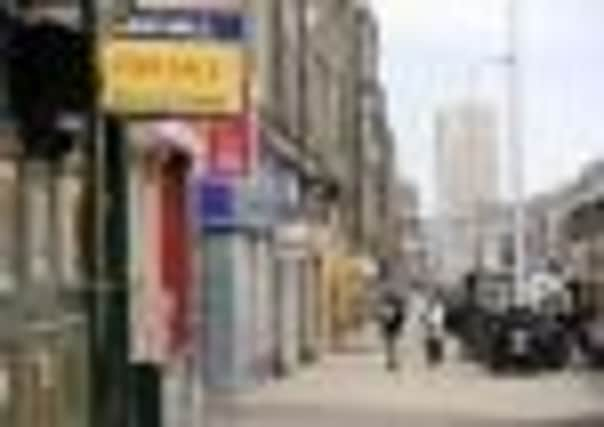Pound shops prosper as chains close 20 shops a day


As clothes shops, travel agents and sports shops shut, there is a shift towards pound shops, pawnbrokers, charity shops and cheque-cashing outlets, the study shows.
Analysts say the picture in Scotland is slightly brighter, with only one shop closure a day. But the number of shops is contracting and the number of new businesses opening continues to fall.
Advertisement
Hide AdAdvertisement
Hide AdThe figures, which cover multiple retailers, show only the rate of shops closing in 2012. But the recent collapse of HMV and Jessops suggests that the rate of decline shows no sign of slowing down in 2013 and experts warn that it may even accelerate.
Across the UK, the figures show multiple retailers closed 7,337 stores and opened 5,558 new ones – a net loss of 1,779.
In Scotland, 353 stores closed last year while 276 opened – meaning multiple retailers had 77 fewer stores in Scotland in total. While the number of shops closing rose by 14 per cent the number of new branches opening fell by 6 per cent –pointing to an overall decline.
Among the most likely to close were shops specialising in cards, computer games, clothes and phones. Those most likely to open were pound shops, pawnbrokers, charity shops, betting shops and coffee shops.
Matthew Hopkinson, director of the Local Data Company, which carried out the research together with accountancy firm PwC, said: “2012 was the first year we have seen significant reductions of multiple retailers in town centres.
“If one takes an average size of 4,000 sq ft per unit, this equates to over 7 million sq ft of space, which is the equivalent of 131 football pitches. We can expect to see this trend continue, and indeed accelerate, in 2013 as more leases come up for renewal, along with demands from consumers for an experience good enough to pull them away from their technology devices.
“The end of 2012 and the beginning 2013 has seen the most dramatic period on record, as companies controlling more than 1,400 shops went into administration.
“Town centres will have to adapt faster than ever before to maintain their attraction. Data to be released tomorrow on independent retailers will add to these woes.”
Advertisement
Hide AdAdvertisement
Hide AdRetail analysts say the increasing popularity of internet shopping means the number of shops on the high street is bound to contract. Over the past few years, many major retailers have called in the administrators – some, such as Woolworths, which closed in 2008, have had to shut all their stores.
However, in cases where a rescue package has been agreed, the trend is for the new owners to keep the most profitable stores open.
Figures for Scotland showed Edinburgh was most severely affected. The capital lost 101 stores in 2012, while only 79 new ones opened – a loss of 22. In Glasgow, 113 stores closed and 95 opened – a net loss of 18 stores.
Bruce Cartwright, head of business recovery services at PwC in Scotland, said: “While the data is a little disappointing, it is perhaps important to acknowledge that a number of businesses with closures had anticipated these for some time. Retailers generally shared two problems – too many stores and too little multi-channel activity.
“What is pleasantly surprising, however, is the speed at which some of these stores have been picked up, by value and grocery stores in particular.”
Spending figures confirm UK’s dire performance
Britain’s dire economic performance at the end of last year was confirmed today, as official figures revealed household spending grew at the slowest rate in a year.
The Office for National Statistics (ONS) said spending on goods and services rose 0.2 per cent between October and December – the lowest since the fourth quarter of 2011 – after slow growth in wages hit consumers.
But there was a chink of light in the economic gloom, as the ONS said the economy expanded as a whole in 2012, up 0.2 per cent against a previous estimate for zero growth.
Advertisement
Hide AdAdvertisement
Hide AdThe revision came after the ONS raised its estimate for third quarter growth from 0.9 per cent to 1 per cent, although it still believes the economy contracted by 0.3 per cent in the final quarter of the year. It will offer little respite for Chancellor George Osborne ahead of next month’s Budget, coming just days after the UK was stripped of its AAA rating by Moody’s.
Chris Williamson, chief economist at Markit, said recent industry surveys suggested the economy would “narrowly” avoid a triple-dip recession with 0.2 per cent growth in the first quarter. “However, none of the root causes of the weakness of the economy has yet been resolved, suggesting very modest growth at best can be expected,” he said.
A marked slowdown in wages growth was behind the drop in household spending in the last quarter, with employee compensation rising by just 0.1 per cent against 0.5 per cent growth in the third quarter.
Business investment fell by 1.2 per cent, while exports fell 1.5 per cent and imports dropped 1.2 per cent. But government spending rose 0.6 per cent in the fourth quarter and by 2.6 per cent as a whole over 2012.
The ONS said output in the powerhouse services sector – which accounts for about 77 per cent of total GDP – was down 0.1 per cent against an initial estimate for zero growth.
Output from the production sector was also revised down even further, to a drop of 1.9 per cent from an 1.8 per cent contraction previously, as mining and quarrying activity was sent plunging by a maintenance closure of the North Sea’s Buzzard oilfield.
An upward revision for construction output – up 0.9 per cent against 0.3 per cent in the initial estimate – was not enough to alter the overall picture for the fourth quarter.